#hephthalites
Text


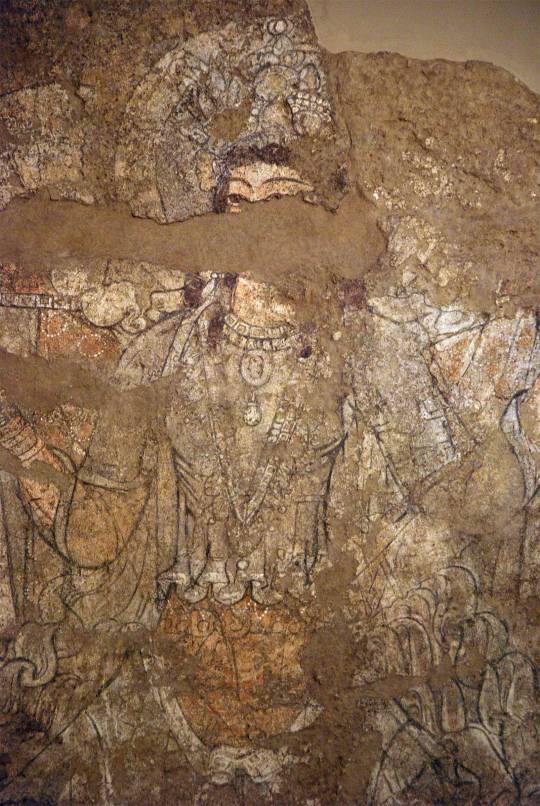





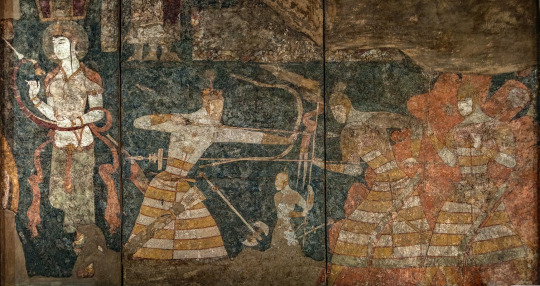



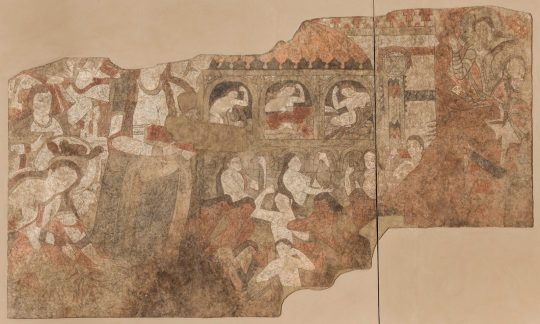





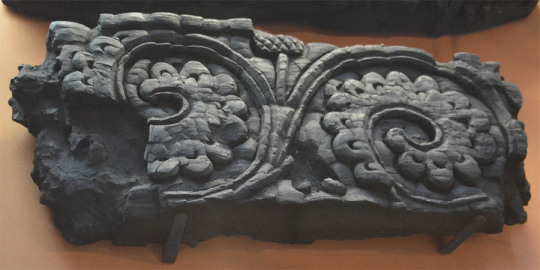




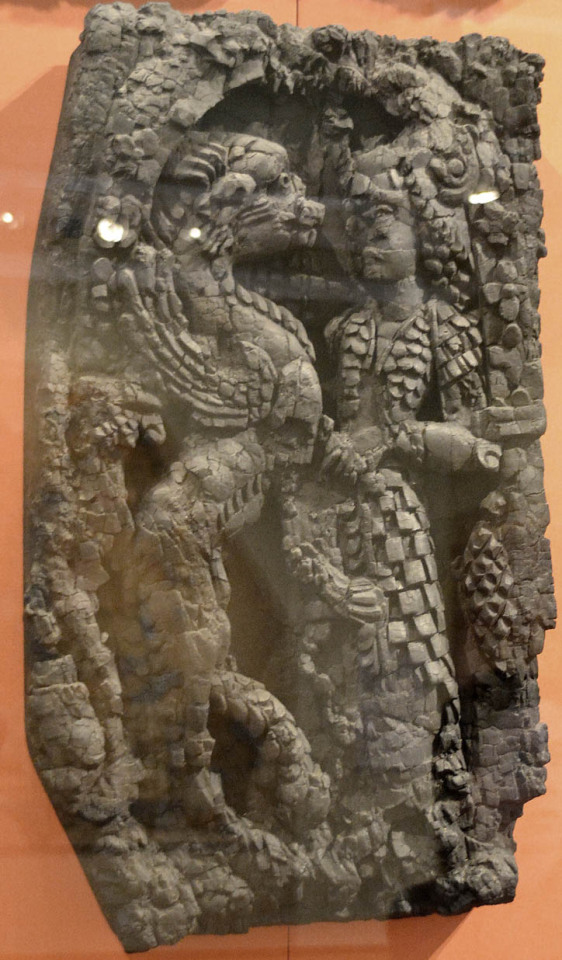

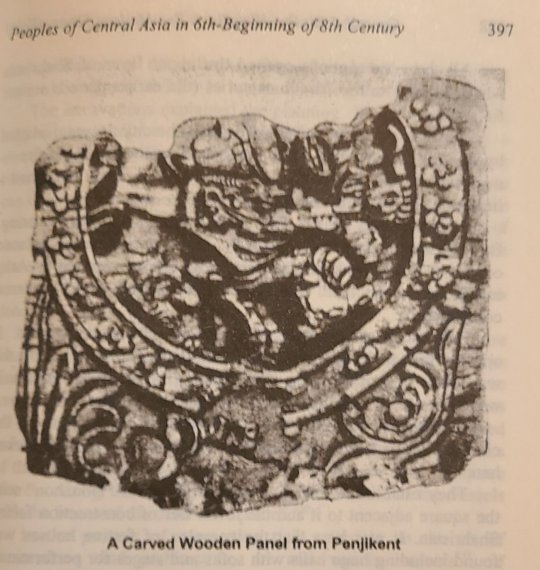

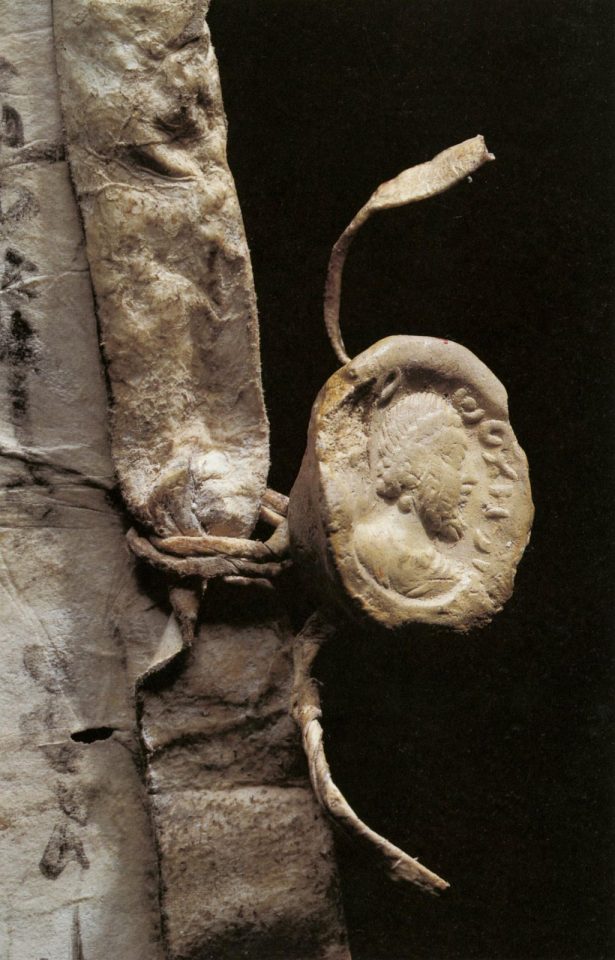
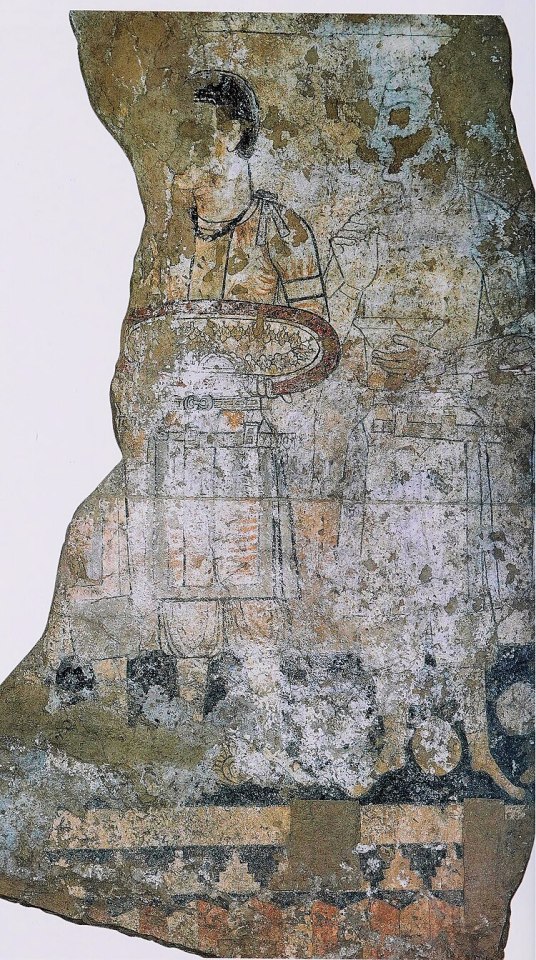
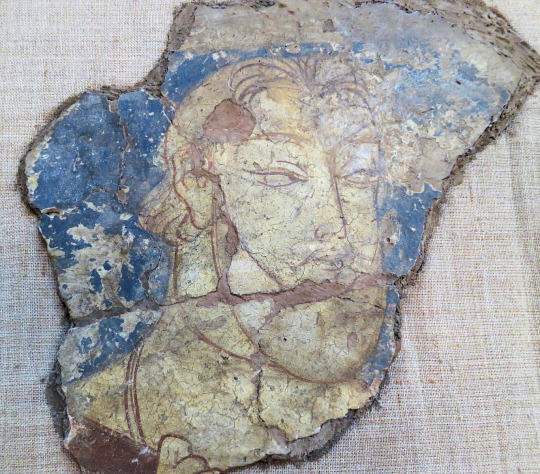
Art from the Sogdian city of Penjakent 5th-8th C. CE. The 3 people in the triple crescent crown may be Hephthalites. A lot more images on my blogspot, link below.
"The Sogdians’ keen interest in depicting the world around them (evidenced by the Hall of the Ambassadors at Afrasiab) and the mythological and supernatural worlds (in many of the Panjikent paintings just discussed) extended into portraying their own world. They did not, as Frantz Grenet points out, represent their mercantile activities, a major source of their wealth, but instead chose to show their enjoyment of it, such as the scenes of banqueting at Panjikent. In these paintings we see how the Sogdians saw themselves.
Chinese representations of Sogdians caricatured them (especially in grooms, musicians, and others of lower status) as having large noses and round eyes, and being heavy-set and generally comical or “barbaric” in appearance. In contrast, the Sogdians’ depictions of themselves show people with fine features—the men (unless rulers or nobles) usually clean-shaven, the women oval-faced and sloe-eyed."
-taken from The Smithsonian
#sogdiana#ancient history#antiquities#history#art#paintings#museums#pagan#paganism#hephthalites#ancient art#medieval art#middle ages#goddess#archaeology
289 notes
·
View notes
Photo

White Huns (Hephthalites)
The White Huns were a race of largely nomadic peoples who were a part of the Hunnic tribes of Central Asia. They ruled over an expansive area stretching from the Central Asian lands all the way to the Western Indian Subcontinent. Although being a mostly nomadic tribe, they nonetheless adopted the lifestyles of the lands they conquered but still retained their warlike nature. Their rule begins in the 5th cent CE, but they lingered on in the region for a substantial amount of time after their kingdom fell and eventually integrated so well into the Indian culture that their practices and traditions became a full part of it.
Continue reading...
70 notes
·
View notes
Text
Afghanistan
Afghanistan is a landlocked country in South Asia, located at the crossroads of Central Asia and South Asia. It is bordered by Pakistan to the east and south, Iran to the west, Turkmenistan, Uzbekistan, and Tajikistan to the north, and China to the northeast. Afghanistan has a long and complex history, and has been the site of many conflicts and invasions throughout its history. In this essay, we…
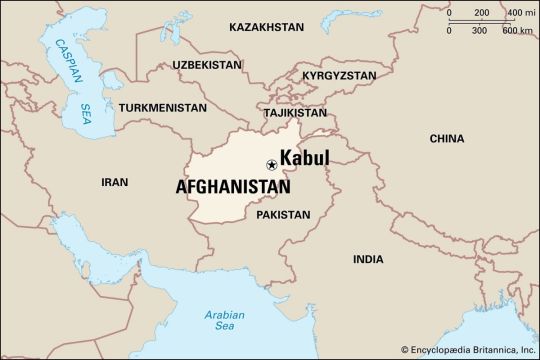
View On WordPress
#Achaemenid Empire#Alexander the Great&039;s empire#ashak#Ashraf Ghani#Central Asia#Hephthalite Empire#Herat#Hindu Kush#ISIS#Islam#Jalalabad#Kabul#kabuli palaw#Kandahar#landlocked#mantu#Mazar-i-Sharif#Mohammed Daoud Khan#mountainous#Pamir mountain ranges#Silk Road#South Asia#Taliban#the Kushan Empire#the Maurya Empire
0 notes
Photo

The painted clay sculpture from this monastery overlooking the Ghorband Valley may be dated in the seventh century A.D. or earlier. This chronology is based not only on the post-Gupta style of the statuary, but also on the finds of coins of the Hephthalite kings and the Sasanian Khusrau II (590-628). From "Ancient Art from Afghanistan: Treasures from the Kabul Museum" by Benjamin Rowland, 1966. https://www.instagram.com/p/CplI_O-tMDN/?igshid=NGJjMDIxMWI=
137 notes
·
View notes
Text
The Monkey King's Crescent-Style Headband
I finally got around to writing an article on the origin of Sun Wukong's crescent-style golden headband. It has ties to not only Chinese opera but also a triple-crescent crown worn by Iranic Hephthalite and Sogdian rulers.
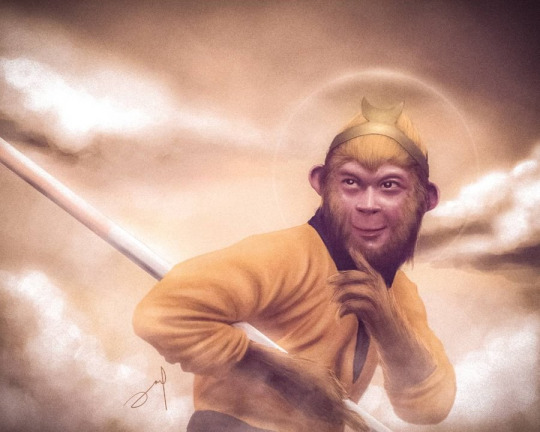
A drawing of Liu Xiao Ling Tong's version of Sun Wukong from the 1986 TV show. Take note of the upturned crescent moon shape in the middle of the headband.
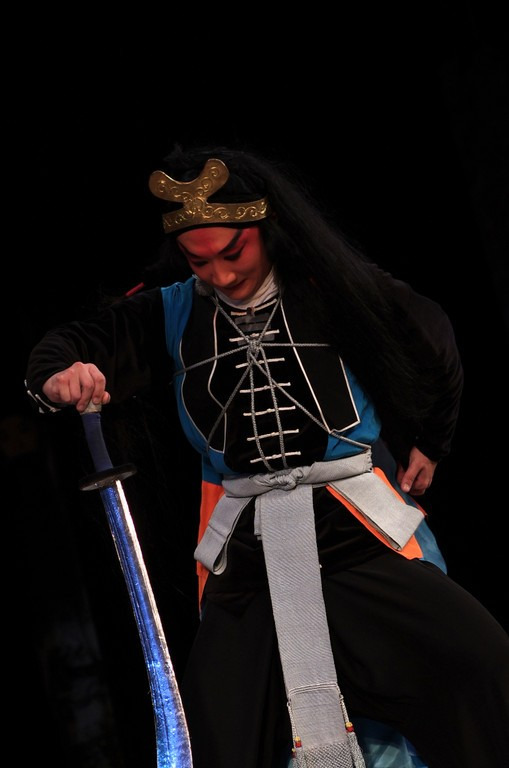
An example of the crescent headband from Chinese opera. The character shown is Wu Song, who shares many similarities with the Monkey King.

Detail from a 6th-century Sino-Sogdian tomb in which the door guardian wears the triple-crescent crown associated with Iranic Hephthalite and Sogdian royalty.
#golden headband#tight fillet#Monkey King#Journey to the West#JTTW#Lego Monkie Kid#Sogdian#Sun Wukong#Sogdiana#China#cultural exchange#Chinese opera
32 notes
·
View notes
Video
youtube
Эфталиты Эбодало - Hephthalites Ebodalo - My Soul Dictionary
0 notes
Note
You created such vibrant and interesting world for your book! I can't wait to find more about it! So Arsur is vaguely based on Persian Empire, Thallos - on greek city-states and Qathesh - on Ancient Egypt. Is there somewhere in your setting countries based on Han dynasty China/ Hephthalites/Gupta Empire/Numidia/varied kingdoms and empires of Africa south of Sahara? I'm so curious!
I haven't fully mapped out the other countries yet since they're not as relevant during the course of this story, but so far the region above Arsur's northern border, past the Armas Mountains, is a steppe zone that would be inspired by Scythia (modern day Central Asia). I included it on the map of Arsur as well, which you'll see in the future!
As for other influences, I would definitely love to expand on those as part of the game's world. I'd have to do more research, obviously, but I did always imagine that further north of Arsur there would be various nations and monarchies inspired by East Asian cultures.
On the eastern border of Arsur there is another sea that hasn't been mentioned (yet) in the story so far. I figure across that sea, on the far eastern side, is where you could place cultures inspired by South East Asia.
I also had some thoughts about the southern part of Hidica, past Qathesh--that's where I'd place countries inspired by African empires and civilizations, such as the region of Nubia. Geographically, I had a fun idea about a small but prominent sea in the center, that splinters outward into rivers throughout the continent, almost splitting various countries into natural borderlines, and fracturing some off into islands.
But I'll consider all that further when I finally draw a map of the entire world, sometime in the distant future haha
#worldbuilding#ask#anonymous#not me realizing how Gigantic i made this continent LMAO#it's really not far off from pangea#there are like 2 huge continents and various large island bodies
106 notes
·
View notes
Text
i think we should bring back the hephthalites just for funsies
2 notes
·
View notes
Text
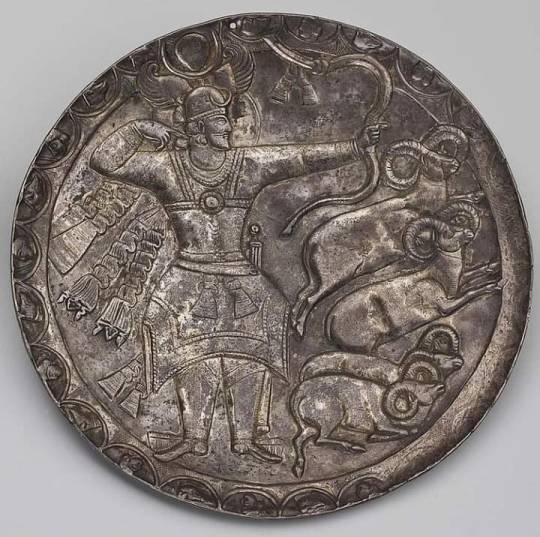
Piruz
1) Etymology
The Persian name Pīrūz with the meaning “victorious, triumphant” is derived from MP. Pērōz, which can be traced back to the Old Iranian composition *pari-auǰah – "having strength/power all around [= through and through]". It consists of *pari – “around, round; about” (~ Ved. pári, Av. pairi, OP. *pari, MP./NP. par) and the noun *auǰah – “strenght, vitality, power“ (~ Ved. ójas, Av. aoǰah,, MP. ōz)
The name is preserved in Iranian languages as:
Parthian. Paryōž
MP. Pērōz
NP. Pīrūz/Fīrūz
The name was borrowed into Non-Iranian languages such as:
Greek. Perózēs/Perṓzēs/Peirózēs
Classical Syriac. Pērōz
Old Armenian. Peroz
Old Georgian. ṗeroz
Chinese. Pílùsī
Arabic. Fayrūz
2) Figures
2.1) Peroz I was the Sasanian King of Kings of Iran from 459 to 484. A son of Yazdegerd II (r. 438–457), he disputed the rule of his elder brother and incumbent king Hormizd III (r. 457–459), eventually seizing the throne after a two-year struggle. His reign was marked by war and famine. Early in his reign, he successfully quelled a rebellion in Caucasian Albania in the west, and put an end to the Kidarites in the east, briefly expanding Sasanian rule into Tokharistan, where he issued gold coins with his likeness at Balkh. Simultaneously, Iran was suffering from a seven-year famine. He soon clashed with the former subjects of the Kidarites, the Hephthalites, who possibly had previously helped him to gain his throne. He was defeated and captured twice by the Hephthalites and lost his recently acquired possessions.
In 482, revolts broke out in the western provinces of Armenia and Iberia, led by Vahan Mamikonian and Vakhtang I respectively. Before Peroz could quell the unrest there, he was defeated and killed in his third war with the Hephthalites in 484, who seized the main Sasanian cities of the eastern region of Khorasan−Nishapur, Herat and Marw. Taking advantage of the weakened Sasanian authority in the east, the Nezak Huns subsequently seized the region of Zabulistan. Peroz was the last shahanshah to mint unique gold coins in the Indian region of Sindh, which indicates that the region was lost around the same period. Albeit a devout Zoroastrian, Peroz supported the newly established Christian sect of Nestorianism, and just before his death, it was declared the official doctrine of the Iranian church.
Peroz's wars against the Hephthalites have been described as "foolhardy" in both contemporary and modern historiography. His defeat and death introduced a period of political, social and religious tumult. (More information at: https://en.wikipedia.org/wiki/Peroz_I)
2.2) Peroz II also known as Gushnasp-Bandeh was king of Persia. He was son of Mah-Adhur Gushnasp and Kahar-dukht, who was daughter of Yazdandad son of Khosrau I. Peroz II reigned only for a short time until he was killed by Sasanian nobles. (from: https://en.wikipedia.org/wiki/Peroz_II)
2.3) Peroz III was son of Yazdegerd III, the last Sasanian King of Kings of Iran. After the death of his father, who legend says was killed by a miller at the instigation of the governor of Marw, he retreated to territory under the control of Tang China. He served as a Tang general and the head of the Governorate of Iran, an exiled extension of the Sassanid court. Most of what is known of Peroz III is written in the Old Book of Tang and the New Book of Tang. (More information at: https://en.wikipedia.org/wiki/Peroz_III)
Image: Plate with a hunting scene involving king Piruz I (from: https://ramiyarkaranjia.com/2021/03/)
2 notes
·
View notes
Photo

Ancient Afghanistan
The ancient history of Afghanistan, a landlocked country in Central Asia, is full of fascinating cultures, from early nomadic tribes to the realms of Achaemenid Persia, the Seleucids, the Mauryans, the Parthians, and Sasanians, as well as steppe people like the Kushans or the Hephthalites. All these civilizations have left their mark on the region, leading to a unique blend of cultures and religions.
Learn more about Ancient Afghanistan
285 notes
·
View notes
Photo
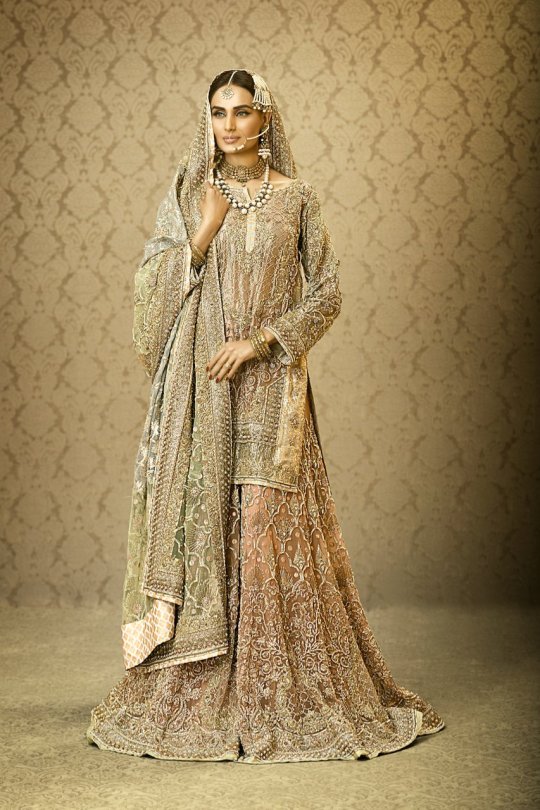
Turkish Moghul / Mughal wedding dress.
Desi / Indian
Stop tagging Mughal Turk clothes as “desi / indian”. Use its original name as it was at the beginning. It has nothing to do with desi / indian clothes (which are sarees, pre-Islamic time clothing and pre-Hephthalite (White Hun Turks) time clothing. Indian and some Pakistani fashion designers can not stop appropriating Turkish motifs and they can not stop describing Turk Moghul clothes as “desi / indian”.
Now some wikipedia readers will come here and they will say that it's persian clothes. They have no clue about how many Turkish empires, dynasties we have had in Persia. We influenced Persia for centuries. Just because it situated in Persia, they call everything "persian". I suggest them to read history about Safavid (Azerbaijani Turkmen) culture. Even their court language was Azerbaijani Turkish !
After the Mongol invasion of Central Asia and other reasons like droughtiness, most of Turkic clans have abandoned their homeland. Some of them migrated to the West Asia, some of them have migrated to the South Asia. And where they went, they created many dynasties, empires. They brought their culture with them.
Bonus : Even this kind of nose ring originated in Central Asia. It has its origin from ancient Turkic religion (Tengrism). Mughals brought this culture of jewellery with them to the South Asia. You can see that there is only few Turkic clans left who practice this tradition of wearing this kind large nose ring in Central Asia, like Karakalpak womens. Mughals just added a chain on it.
#mughals#mughal culture#mughal dress#turkish culture#turkic culture#turkic clothes#turkmen culture#mughal sarai clothing#pakistan#south asia#desi#india#mughal empire#türk#lehenga#dupatta#zardosiwork#pakistani fashion#central asian dress#central asian culture#central asian turkic#babur empire#babür imparatorluğu
45 notes
·
View notes
Text
#Tarkhan (#ਤਰਖਾਣ)
Tarkhan is a north Indian tribe which has been historically present in a Punjab and its nearby areas. Tarkhans are an ethnic minority and most of Tarkhans are followers of Sikhism and small number is a follower of Hinduism. Very small of number of ethnic Tarkhans are found in Pakistan, these Tarkhans are followers of Islam. Tarkhans are subdivided into various clans (ਗੋਤ).
Tarkhan #Occupations:
Tarkhan occupations are carpentry, blacksmithing, masonry and farming. The Lohars (blacksmiths) of Punjab are Tarkhans who work with metals and term Tarkhan-Lohar is also used. This diversity in Tarkhan occupations is very clear from Sikh history, where different Tarkhan-Sikhs had different occupations. For example: Baba Lalo Ghattaura, one of the first Sikhs of Guru Nanak was a carpenter, family of Baba BHAI Roop Chand has always been farmers, Baba Hardas Singh Bhamra made the famous nagni used to kill the drunken elephant, he was also scholar, and close associate of 10th Sikh Guru, and Mistry Des Raj Kalsi of Sur Singh played an important role in re-construction of Akal Takht after it was destroyed by Ahmed Shah Abdali. In modern day Punjab, every house, every building is made by Tarkhans, all machinery such as combines, ploughs and harvesters are made by Tarkhans including manufacturing of tractors, also welding and repairing despite being a small minority. Tarkhans are the only people in Indian sub-continent to be masters of more than occupations.
#Ancient #History of Tarkhans:
Kasgarli Mahmut was 11th century scholar from Kashgar. He explained the word Tarkhan in the following way: "It is a name given before the Islamic religion. It means prince (Bey, Umar) in Arghu language." It is clear the word Tarkhan was not pure Turkish and that it was adopted into Turkish from the old language of Sogdiana. This was proved in the Turkish dictionary Divan u Lugat it-Turk written by Kasgarli Mahmut. Sogd was a name of a nation who settled in Balasagun. These were of the Sogd race. Sogd lay between Bukhara and Samarqand. Sogdia (/ˈsɒɡdiə/) or Sogdiana was an ancient Iranian civilization.
Historian H. Beveridge in his paper titled Tarkhan and Tarquinius points out that antiquity of Tarkhan is evidenced by the fact it's etymology is lost. He also states that Tarkhan was both a personal title and the name of a tribe. Bipin Shah in his paper titled Patali of Alexander, Sack of Nagar Thatta and Arghoon rule of Sindh talks about pre-historic central asian tribe named Tarkhan. Beveridge, Isaac Taylor, C. R. Condor and J. G. R. Farlong in their writings all agree that Tarkhan, Tarkan and Tarquin are same. Lucius Tarquinius Priscus, or Tarquin the Elder, was the legendary fifth king of Rome from 616 to 579 BC. Tarkhan was used among the Hittites (1700BCE- 1200BCE) to refer the tribal Chiefs. Also, the the Kassites (1531BCE-1155 BCE) had god called Tartakhan.
Khodadad Rezakhani of Freie Universität (Berlin) in the paper titled Continuity and Change in Late Antique Irān: An Economic View of the Sasanians writes (year is 560 AD): "These are the famous Nezak Tarkhans who claimed descent from the Alkhon king Khingila (Grenet 2002: 218). We know that these Tarkhans controlled the passes across the Hindukush both to Bamiyan and also to Kabul, via the Panjshir Valley (Baker and Allchin 1991). Based on the pattern of the earlier Hephthalites, they established and controlled formidable castles on both sides of the Surkhab River in southern Tokharistan, controlling the trade and military route from Bactria to Bamiyan (Grenet 2002: 218-20)."
In Eras of Humanity by Genealogy, Brian Starr writes about Kama Tarkhan of Huns. Hiuen Tsang, a Chinese traveller of 7th century AD also mentions various Tarkhans in Indian subcontinent such as Tarkhan of Samarkand, a meeting between king and 200 Tarkhans. Across the Hindukush of the First Millennium a collection of the papers by S. Kuwayama makes the mention of Chebishi Tarkhan who along with Tafu Tegin was sent to court of Tang Dynasty by King of Gandhara in 753 AD. Tarkhan Dynasty ruled over Gilgit in 7th and 8th century and was founded by a prince from Badakhshan. Further, founders of Maglot dynasty of Nagar and Ayash dynasty of Hunza were both Tarkhan princes. Tradition traces the origin of these Tarkhans to an imaginary Kayāni prince of Persia, by name Azur Jamshid, who is said to have fled here after the Arab conquest of Persia.
The town named Tarkhan in Egypt has been a site of various archeological diggings, some which were as old as 4000 BCE and oldest woven piece of cloth called Tarkhan Dress. In the town of Chal Tarkhan (Iran) many artifacts were found belonging to Sassanian Period (224 to 651 AD). Tarkhankut is name of peninsula in Ukraine and there are various places named Tarkhan in Russia. Tarkhans have been present in Indian subcontinent atleast since 6th century AD.
The ancient history of Tarkhans is also evidenced from the origin of various Tarkhan clans, such as Ubbi was a Germanic tribe and Bahra a Arabic tribe. There are places named after various Tarkhan clans in Iran (Panesar E-Takshan, Hunejan etc) and Tarkhan clans such as Siyan and Salh are also found among Kurds. Padam and Rattan being of native Indian origin. Menander 1 a Indo-Greek king was born in place named Kalasi (Alexandria of the Caucasusn) around 165 BCE. More than 90% Tarkhans have Tarkhan exclusive clans, only a very little overlap with others.
Some Tarkhan #Personalities:
• Jugde Dalip Singh Saund: First Asian to become Judge in US and get elected in US Congress. His son Dalip Saund Jr. served in US Army as a Lieutenant during Korean war.
• Satnam Singh Bamrah: First N.B.A player from India.
• Bardish Chaggar: First female Leader of the Government in the House of Commons in the history of Canada.
• Baba Sukha Singh Kalsi: There are 7 episodes dedicated to his bravery in Panth Prakash.
• Sir Mota Singh Matharu, QC: First Asian to become judge in United Kingdom.
• Lt-Colonel Kamal Kalsi (US Army).
𝗧𝗮𝗿𝗸𝗵𝗮𝗻 #𝗣𝗼𝗽𝘂𝗹𝗮𝘁𝗶𝗼𝗻:
According to 1881 census of British India there were 263,479 Tarkhan Sikhs. In the book The Crucial Decade by S.C. Sharma writes that Tarkhans too are found in all the three religious groups in this province, on 1921 their numerical strength in the (United) Punjab was 684,000. The small population of Tarkhans is also evidenced from the fact most of villages in Punjab used to have only three to four houses of Tarkhan families.
List of Tarkhan #Villages (Incomplete):
• Bhai Rupa (ਭਾਈ ਰੂਪਾ), Thathi (ਠੱਠੀ), Siriyewala (ਸਿਰੀਏਵਾਲਾ), Nehianwala (ਨੇਹੀਆਵਾਲਾ), Dialpura Bhaika (ਦਿਆਲਪੁਰਾ ਭਾਈ ਕਾ), Towala (ਟੋਵਾਲਾ), Samadh Bhai Ki (ਸਮਾਧ ਭਾਈ ਕੀ), Ravleri (ਰਾਵਲੇਰੀ), Lakhnor (ਲਖਨੌਰ)
• Sikhwala (ਸਿੱਖਵਾਲਾ) Kotha Rajasthan (ਕੋਠਾ ਰਾਜਸਥਾਨ), Kabool Shah Khubban (ਕਬੂਲ ਸ਼ਾਹ ਖੁੱਬਣ)
• Muktsar (ਮੁਕਤਸਰ): Tarkhan Wala (ਤਰਖਾਣ ਵਾਲਾ), Akalgarh (ਅਕਾਲਗੜ੍ਹ)
• Tarkhan Majra (ਤਰਖਾਣ ਮਾਜਰਾ) (Amloh ਅਮਲੋਹ)
• Garhi Tarkhana (Macchiwara) ਗੱੜੀ ਤਰਖਾਣਾਂ (ਮਾਛੀਵਾੜਾ)
• Channian (ਚਾਨੀਆਂ) (Nakodar ਨਕੋਦਰ)
• Jallandhar (ਜਲੰਧਰ): Tarkhan Majra (ਤਰਖਾਣ ਮਾਜਰਾ), Mothanwala (ਮੋਠਾਂਵਾਲਾ)
• Hoshiarpur (ਹੁਸ਼ਿਆਰਪੁਰ ਜ਼ਿਲ੍ਹਾ):Bhattian (ਭੱਟੀਆਂ), Chatowal (ਚੱਤੋਵਲ), Halerh Ghogra (ਹਾਲੇੜ ਘੋਗ ਰਾ), Choka (ਚੋਕਾ)
• Gurdaspur (ਗੁਰਦਾਸਪੁਰ ਜ਼ਿਲ੍ਹਾ): Rangilpur (ਰੰਗੀਲਪੁਰ), Dhadiyala (ਢਡਿਆਲਾ), Sada Rang (ਸਦਾ ਰੰਗ)
• Kapurthala (ਕਪੂਰਥਲਾ): Ahmedpur (ਅਹਿਮਦਪੁਰ), Tarkhanawali (ਤਰਖਾਣਾਵਾਲੀ)
• Phagwara (ਫਗਵਾੜਾ): Lohara (ਲੋਹਾਰਾ), Ramgarh (ਰਾਮਗੜ)
• Tarkhan Majra (ਤਰਖਾਣ ਮਾਜਰਾ) (Samana ਸਮਾਣਾ)
• Tarkhan Majra (ਤਰਖਾਣ ਮਾਜਰਾ) (Sirhind ਸਰਹਿੰਦ)
• Bagrian (ਬਾਗੜੀਆਂ)
• Vakilanwala ਵਕੀਲਾਂਵਾਲਾ (Ferozpur ਫਿਰੋਜ਼ਪੁਰ)
Tarkhan #Traditons
Tarkhans engage in ancestor worship in the form of Jathere (ਜਠੇਰੇ) and Matti (ਮੱਟੀ), different Tarkhan clans have different jathere However, this practice is now dying. Members within a same clan (ਗੋਤ) are related by blood. For marriages, Tarkhan practice class endogamy but clan exogamy i.e. they marry with Tarkhans only, however outside their maternal (ਨਾਨਕੇ) and paternal (ਦਾਦਕੇ) clans.
#Ramgarhia:
Some Tarkhan Sikhs identify with Ramgarhia as Ramgarhia Misl (Ramgarhia Confedration) was the one of most powerful Sikh Misl out of 12 misls. The founder and leader of Ramgarhia Misl was Maharaja Jassa Singh Bhamra, who was a Tarkhan himself and most of soldiers in Misl were from Tarkhan tribe. Strength of Misl is evidenced from fact that Ramgarhia Misl along with other sikh generals won Delhi and it was Jassa Singh Ramgarhia who dragged the Mughal throne from Delhi to Akal Takht, where it lies even today in Ramgarhia Bungas. In the Tawarikh Darbar Sahib by Udham Singh, it is written that Maharaja Jassa Singh of Ramgarhia Misl and his son Sardar Jodh Singh together contributed Rs 5 Lakh for construction of Ramgarhia Bungas.
#References:
1. Tarkhan and Tarquinius by H. Beveridge of The Journal of the Royal Asiatic Society of Great Britain and Ireland.
2. Anatolian Iron Ages: The Proceedings of the Second Anatolian Iron Ages Colloquium held at İzmir, 4-8 May 1987
Edited by A. Çilingiroğlu and D. H. French, Page 115.
3. Era's of Humanity by Genealogy written by Brian Starr, Page 204
4. A Socio-Political Study of Gilgit Baltistan Province by Omar Farooq Zain.
5. THE WESTERN HIMALAYAN STATES by A. H. Dani.
6. A SHORT HISTORY OF AFGHANISTAN By Professor Abdul Hai Habibi, President, Historical Society of Afghanistan.
7. Across the Hindukush of the First Millennium: a collection of the papers by S. Kuwayama.
8. Continuity and Change in Late Antique Iran: An Economic View of the Sasanians by Khodadad Rezakhani of Freie Universität, Berlin.
9. FAITHS OF MAN: A CYCLOPÆDIA OF RELIGIONS BY MAJOR-GENERAL J. G. R. FORLONG, M.R.A.S., F.R.G.S., F.R.S.E., M.A.1, A.I.C.E., F.R.H.S.
10. THE HITTITES AND THEIR LANGUAGE BY C. R. CONDER, LT.-COL. R.E.
11. Patali of Alexander, Sack of Nagar Thatta and Arghoon rule of Sindh by Bipin Shah
12. PERSPECTIVES ON THE SIKH TRADITION, Edited by GURDEV SINCH, Foreword by KHUSHWANT SINGH
13. Tarkhan Nīzak or Tarkhan Tirek? An Enquiry concerning the Prince of Badhghīs Who in A. H. 91/A. D. 709-710 Opposed the 'Omayyad Conquest of Central Asia.
14. RAJ KHALSA PART - Iwritten by Giani Gian Singh.
2 notes
·
View notes
Text
Tajikistan
Tajikistan
Tajikistan is a landlocked country in Central Asia. It covers an area of 143,100 square kilometers (55,300 square miles) and has an estimated population of 9537,645. Traditional settlements of the Tajik people include parts of present-day Tajikistan and Afghanistan and Uzbekistan.
The region that now constitutes Tajikistan was formerly home to many ancient cultures, the city of Sarjam in the New Stone Age and the Bronze Age, and later the states ruled by people of different religions and cultures, including the Axis Valley civilization, such as the Andronovo, Buddhist, and Buddhist religions. Manik religion and Islam The region has been ruled by a number of empires and dynasties, including the Achaemenid Empire, the Sassanian Empire, the Hephthalite Empire, the Samanid Empire, and the Mongol Empire. The region later became part of the Russian Empire and later the Soviet Union. Within the Soviet Union, it was first established as an autonomous democracy in Uzbekistan, and later in 1929 as a full-fledged Soviet democracy. On September 9, 1991, Tajikistan became an independent sovereign state after the collapse of the Soviet Union.
Geography
Tajikistan is the smallest country in Central Asia by region It is located approximately 36 ° to 41 ° north latitude, and 67 ° to 75 ° east It is covered by the Pamir mountain range and most of the country is more than 3000 meters (9,800 feet) above sea level. The only major part of the plain is to the north (part of the Fergana Valley) and to the south of the Coffernihon and Vach river valleys, from where the Amu Darya river is formed. The city of Dushanbe is located on the southern slope of the Coffernihon Valley. The Amu Darya and Panj rivers mark the border with Afghanistan. Icebergs in the mountains of Tajikistan are the main source of water for the Aral Sea. There are more than 900 rivers in Tajikistan with a length of more than 10 km.
Rule--
Tajikistan is officially a presidential democracy. The president is both head of state and head of government. Both the executive branch and the two houses of parliament have the power to legislate. Regular elections are held for the President and Parliament. It is a multi-party system with only one party. The People's Democratic Party of Tajikistan regularly holds a majority in parliament. Emomali Rahman has been the President of Tajikistan since November 1994. The prime minister is Kokhir Rasuljoda, the first deputy chief minister is Mattalbukhan Davlatov, and the two deputy chief ministers are Murodali Alimordan and Rukia Kurbanova.
Economy--
About 47% of Tajikistan's GDP comes from Tajiks (mostly Russians working in Russia). According to some estimates, about one-fifth of the population lives on less than $ 1.25 a day.
0 notes
Video
youtube
Эфталиты Эбодало - Hephthalites Ebodalo - My Soul Dictionary
0 notes
Text
6th Century, 501 to 600
501 In Central America, the Maya are peaking in economic prosperity. The civilization at Teotihuacán (in what is today Mexico) begins to decline and its people are migrating to the greatest Mayan city, Tikal, bringing with them ideas about weaponry and new ritual practices. Maya population is rising.
507 The Franks, who are Catholic, use the Arian Christianity of the Visigoths as an excuse to expand against them – Catholics seeing Arianism as a heresy. The Franks defeat the Visigoths, kill their king, Alaric II, and drive them into Spain.
511 Clovis, king of the Franks, dies and, as is custom among the Franks, the lands of Clovis are divided among his four sons, beginning the sordid rule of Europe's "Merovingian" kings.
523 In northern China, power within the Tuoba Wei family (a Xiongnu family rather than Chinese) has passed to a dowager queen who is a devout Buddhist – Queen Hu.
524 One of the four sons of Clovis, Clodomer, dies, and two of the other sons of Clovis, Clotaire and Childebert, seize Clodomer's lands for themselves and murder his children.
525 Living in Italy under the rule of Theodoric, king of the Ostrogoths, Boethius has been accused of treason and imprisoned. He has written his work On the Consolation of Philosophy while in captivity, and in a year he is executed.
528 Hephthalites (White Huns) have moved from the Hindu Kush into the Punjab and eastward across the Ganges Valley, ravaging cities, towns and Buddhist monasteries, and now they are driven back, out of the Ganges Valley.
528 Despite her Buddhism, Queen Hu has resorted to an old monarchist tool: killing people. She has executed lovers who have displeased her. She has forced a rival into a convent and has had her executed, and in 528 she executes her son, who was growing restless under the tutelage of her lovers.
529 Justinian, Catholic Roman emperor at Constantinople since 518, closes down Plato's old academy in Athens as part of a move to stamp out paganism.
531 Khosrau I, of the Sassanian dynasty, comes to power in Persia. He has crushed the communistic Mazdakite movement and has ended decades of disorder. He is to support Zoroastrianism and to reform and improve Persia's economy, making taxes more equitable and curbing the power of aristocrats.
533 Getting the world ready for the Second Coming of Christ, Emperor Justinian sends his army to reconquer what had been parts of the Roman Empire. In North Africa he defeats the Vandals, who are Arian Christians, and he conquers territory and souls for the Church.
534 Continuing the Frankish tradition of making war for the sake of plunder, Clotaire and Childebert have overrun the kingdom of Burgundy – including the cities of Lyons and Geneva. The royal dynasty in Burgundy ends with the death of Gundimar. An independent Kingdom of Burgundy is no more.
534 Toledo becomes the capital of the Visigoth kingdom in Spain.
534 Outraged court officials rebel against Queen Hu. She cuts her hair and seeks refuge in a Buddhist nunnery, but the officials drag her out and assassinate her. Also, two thousands courtiers are killed. Northern China divides between western and eastern halves of the Wei dynasty.
536 Justinian's army invades Italy at Naples.
550 What had been Roman-ruled Britain is largely divided among illiterate Anglo-Saxon warlords, surrounded by men who are preoccupied with fighting, valor and loyalty. They look with contempt upon the what they see as the defeated God of the defeated Christians.
550 Rule in India is again divided among numerous kingdoms. Profitable trade with the Roman Empire has ended, and trade with Persia had also declined, which brings decline to some of India's cities. In India a movement called Bhakti has begun and is growing. They practice humility and sing of their adoration and love for a generous, merciful, supreme God.
554 Justinian's' army defeats the Ostrogoths of Italy. Rome and much of Italy is in ruin. The Pope and Catholicism now reign supreme in Rome and central Italy. The Trinity version of Christianity has won against Arianism, violence again deciding a matter of theology.
560 The Hephthalites have returned to their power center near Samarkand. They are attacked, defeated by a Persian-Turkish alliance, the Persians taking revenge for the defeat that the Hephthalites had given their forefathers the previous century. The Hephthalites vanish as an identifiable people.
560 Ethelbert I succeeds his warlord father, Eormenric, in a kingdom in southern England called Kent – one of the older if not oldest Anglo-Saxon settlements in England, dating from the mid-400s or a couple of decades earlier. The young Ethelbert is soon to marry the Catholic daughter of the king of Paris, Charibert, a grandson of Clovis.
568 Constantinople has been weakened by its prolonged wars and by warring tribes into its empire. The Lombards invade Italy, reaching Milan.
577 A Xiongnu chieftain, Yan Ch'ien, unifies northern China by force.
581 Diffusion brings Chinese rule in northern China back to the Chinese. The Xiongnu chieftain, Yan Ch'ien, dies in 580 under mysterious circumstances. Replacing him is his son-in-law, Yang Jian, a tough Buddhist soldier from an aristocratic Chinese family, who has had the title Duke of Sui. Yang Jian proclaims that heaven and earthly signs indicate that he, being virtuous and wise, has been designated by heaven as the rightful successor. He takes the name Emperor Wen, and to eliminate rivalry he has fifty-nine people murdered. The Sui Dynasty has begun.
587 In Japan, the Soga clan, which has intermarried with the royal Yamato family, fights the Mononobe and Nakatomi clans over influence in selecting a successor to the Emperor Yomei has taken place. The Soga favor importing Buddhism from the Asian mainland, described there as the religion of the most civilized. The Mononobe and Nakatomi hold that Buddhism would be an affront to the gods of the emperor. The Soga win the civil war. The head of the Soga family, Umako, makes his nephew, Sujun, emperor.
588 In Spain, the king of the Visigoths, Recared I, has discarded Arian Christian and converts to Catholicism. And as the king goes, so goes his nation.
589 From northern China, Emperor Wen has gained power through the south. After 271 years of division, China is again united.
592 Emperor Sujun wants to be rid of his benefactor, Umako, but Umako strikes first and has Sujun murdered. Umako places his thirty-nine year-old daughter, Suiko, on the throne and makes her twenty-nine year-old nephew, Shotoku, regent.
594 Shotoku converts Suiko to Buddhism. Buddhism becomes the state religion and is called upon to protect the Japanese nation.
600 Monotheistic religion has spread to Arabia. Jews have been in Arabia for centuries. Christian missionaries have been in Arabia for more than a century. The entire Arabian province of Najran is Christian. Christianity has been established superficially in various other centers of trade, and Arabs living on the borders of Constantinople's empire and Persia's empire have been influenced by those empires.
0 notes
Text
Discovering the world
Afghanistan 🇦🇫
Basic facts
Official name: د افغانستان اسلامي امارت (Də Afġānistān Islāmī Imārat [Pashto])/امارت اسلامی افغانستان (Imārat-i Islāmī-yi Afghānistān [Persian]) (Islamic Emirate of Afghanistan)
Capital city: Kabul
Population: 42 million (2023)
Demonym: Afghan
Type of government: unitary totalitarian theocratic Islamic emirate
Head of state: Hibatullah Akhundzada (Supreme Leader)
Head of government: Abdul Kabir (Prime Minister)
Gross domestic product (GDP) (purchasing power parity, PPP): international $67.13 billion (2021)
Gini coefficient of wealth inequality: 65.5% (high) (2019)
Human Development Index: 0.478 (low) (2021)
Currency: afghani (AFN)
Fun fact: Women in Afghanistan earned the right to vote in 1919, one year before their counterparts in the United States.
Etymology
Some scholars suggest that Afghān is derived from the Sanskrit word Aśvakan, which literally means “horsemen” and was the name used for ancient inhabitants of the Hindu Kush mountain range. Historically, it was used to refer to ethnic Pashtuns.
“-stan” is a Persian suffix meaning “place of”, so “Afghanistan” translates to “land of the Afghans” or “land of the Pashtuns”. The term was first officially used in 1855, when the British recognized Dost Mohammad Khan as king of Afghanistan.
Geography
Afghanistan is a landlocked country located between Central and South Asia. It borders China and Tajikistan to the northeast, Pakistan to the east and south, Iran to the southwest, Turkmenistan to the northwest, and Uzbekistan to the north. Its strategic position due to its easy access to many Asian regions has turned it into a battleground for global superpowers, such as the Soviet Union, the United Kingdom, and the United States. However, none have managed to control the Afghanistan for long, which is why it is known as the “graveyard of empires”.

There are several climates: desert in the south, humid continental and subartic in the mountains, Mediterranean in the west, and semi-arid in the rest of the country. As a result, extreme temperatures ranging from -25 °C (-13 °F) to 43 °C (109.4 °F) have been registered. The average annual temperature is 12.6 °C (54.6 °F).

The country is divided into 34 provinces (wilayat), and these in turn are divided into 421 provincial districts (wuleswali). The largest cities in Afghanistan are Kabul, Kandahar, Herat, and Mazar-i-Sharif.

History
3300-2350 BCE: Helmand culture
7th-6th centuries BCE: Median dynasty
550-330 BCE: Achaemenid Empire
330-305 BCE: Seleucid Empire
305-185 BCE: Maurya Empire
185-145 BCE: Indo–Greek Kingdom
145-124 BCE: Indo–Scythian Kingdom
124 BCE-19 CE: Parthian Empire
19-226: Indo–Parthian Kingdom
30-375: Kushan Empire
224-365: Sasanian Empire
320-450: Kidarites
450-665: Hephthalites
642: Arab Muslims bring Islam to Afghanistan
665-822: Turk Shahis
822-870: Hindu Shahis
870-977: Saffarid dynasty
977-1186: Ghaznavid Empire
1186-1215: Ghurid dynasty
1215-1219: Anushtegin dynasty
1219-1370: Mongol Empire
1290-1320: Khalji dynasty
1370-1507: Timurid Empire
1501-1736: Safavid Empire
1501-1785: Khanate of Bukhara
1520-1554: Arghun dynasty
1526-1857: Mughal Empire
1709-1738: Hotak dynasty
1738-1747: Afsharid dynasty
1747-1823: Durrani Empire
1747-1892: Maimana Khanate
1793-1863: Emirate of Herat
1818-1855: Emirate of Kandahar
1823-1855: Emirate of Kabul
1838-1842: First Anglo–Afghan War
1839-1842: Durrani Kingdom
1842-1926: Emirate of Afghanistan
1863-1869: First Afghan Civil War
1878-1880: Second Anglo–Afghan War
1879-1919: British protectorate of Afghanistan
1919: Third Anglo–Afghan War; Afghan independence from the United Kingdom; demarcation of the Durand Line
1926-1973: Kingdom of Afghanistan
1928-1929: Second Afghan Civil War
1944-1947: Khost disturbances
1973-1978: Republic of Afghanistan
1978-1987: Democratic Republic of Afghanistan
1979-1989: Soviet–Afghan War
1987-1992: Republic of Afghanistan
1989-1992: Third Afghan Civil War
1992-1996: Islamic State of Afghanistan; Fourth Afghan Civil War
1996-2001: Islamic Emirate of Afghanistan; Fifth Afghan Civil War
2001-2014: Operation Enduring Freedom
2001-2004: Afghan Interim and Transitional Administration
2004-2021: Islamic Republic of Afghanistan
2015-2021: Operation Freedom’s Sentinel
2015-present: Islamic State–Taliban conflict
2021: Islamic Emirate of Afghanistan; beginning of the republican insurgency
Economy
Despite Afghanistan’s abundant mineral deposits, it remains one of the world’s least developed countries due to its rough physical geography, landlocked status, and political instability. The country’s imports, which mostly come from China, Iran, and Pakistan, are vastly superior to its exports, which largely are in the form of fruits and nuts and go to India and Pakistan.
Its service sector contributes the most to the GDP (56%), followed by agriculture (23%) and industry (21%). Nevertheless, agricultural production is the backbone of Afghanistan’s economy, employing about 40% of the workforce. The country is known for its apricots, grapes, pomegranates, rugs, and saffron. It is also the world’s largest producer of opium.
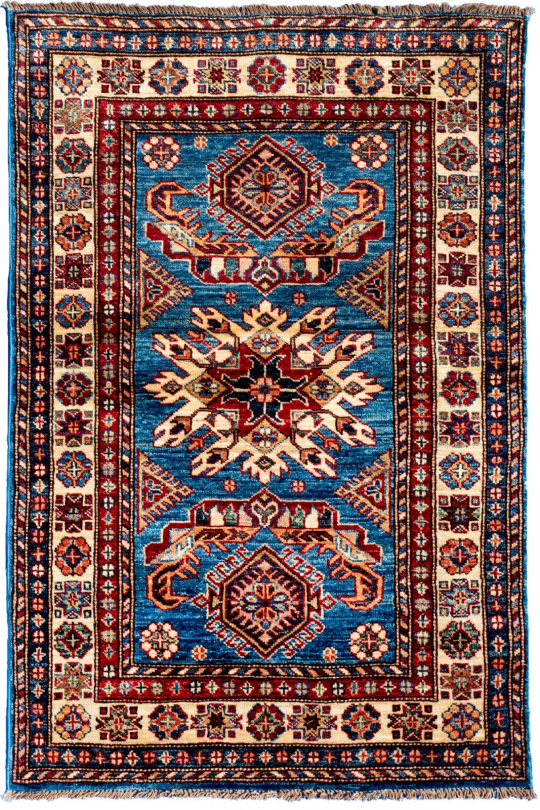
Afghanistan is a member of the Economic Cooperation Organization (ECO), South Asian Association for Regional Cooperation (SAARC) and Organization of Islamic Cooperation (OIC) and has observer status in the Shanghai Cooperation Organization (SCO).
Demographics
Afghanistan is a multi-ethnic and multilingual country, with fourteen recognized ethnic groups, of which the largest ones are the Pashtun (52%), Tajik (27%), Hazara (9%), and Uzbek (8%). Islam is the official religion of the country, and around 99% of the population is Muslim, with 90% of them being Sunni and 7% Shia. There are also some Christian, Hindu, and Sikh communities.
Although Afghanistan has a negative net migration, its fertility rate of 4.6 births per woman pushes the population up. Only 26% of the population lives in cities, which is one of the lowest figures in the world, and only the capital city has over a million residents. Life expectancy is 66 years and the median age is 18.4 years. The literacy rate is 43%, 55% for men and 30% for women.
When the Taliban came into power in 2021, they restricted women’s rights and mobility by imposing a ban on secondary education for girls, enforcing a strict dress code, and forbidding them from leaving the house without a male guardian (mahram).
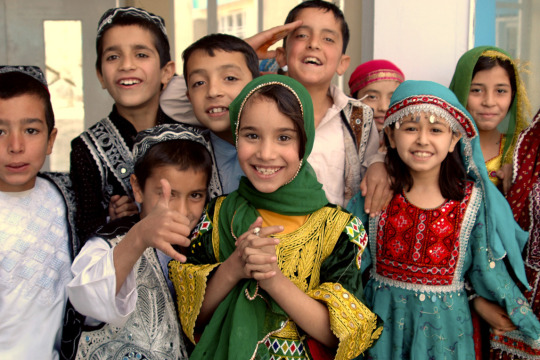
Languages
The official languages of the country are Dari, often referred to as Farsi and spoken by 78% of the population, and Pashto, spoken by 50% of the population. Dari, a Western Iranian language from the Indo-European family, is the official name for Persian in the country and widely used as a lingua franca by different ethnic groups. Pashto, an Eastern Iranian language, is also widely spoken but not commonly spoken by non-Pashtuns.

Other commonly-spoken languages are Uzbek (10%), English (5%), Turkmen (2%), and Urdu (2%). Turkmen and Uzbek are both Turkic languages and official in areas where the majority speaks them.
Culture
Family is the pillar of life in Afghanistan, and family’s interests supersede personal desires and obligations to one’s ethnic group. Afghans are culturally Persian and Turkic. Pashtuns follow the Pashtunwali (the Pashtun lifestyle), whose key tenets are hospitality, the provision of sanctuary to those seeking refuge, and revenge for the shedding of blood.
Afghan clothing typically consists of shalwar kameez, a combination of trousers (shalwar) and a long shirt or tunic (kameez), especially perahan tunban and khet partug. Women normally wear a chador for head covering, although highly conservative ones wear a burqa, a full body clothing that covers the eyes with a mesh screen. Since the Taliban takeover, all women are required to wear it. Men wear chapans as coats and karakuls—peaked and made from black sheep fur—and pakols—woolen, flat, and round-topped in earthy colors—as hats.

Households are large and multigenerational, with an average size of 7.8 people, as it is rare for married couples to move out of their parents’ houses due to economic circumstances. Endogamous marriages with parallel and cross-cousins are preferred. Polygyny is legal if the man proves he can economically support all the wives. Divorce is rare and stigmatized.
Architecture
Afghanistan’s architecture reflects the country’s location at the crossroads of Central Asia, the Indian subcontinent, and the Iranian plateau, as well as Buddhist, Greek, Islamic, and Zoroastrian influences.
The stupa is a traditional mound-like construction containing Buddhist relics. Traditional Islamic constructions include mausoleums, minarets, and mosques. The traditional architecture of the country is characterized by stone foundations, brick and timber frames, wooden beams, mud and bamboo roofs, and mud and straw walls, although concrete houses are now increasingly common.

Cuisine
The Afghan diet is based on barley, dairy products, fruit, maize, rice, vegetables, and wheat. A typical meal consists of meat, naan bread, rice, tea, and yogurt. Typical dishes include aushak (pasta dumplings filled with chives, with tomato sauce, and topped with yogurt and dried mint), chapli kabab (a minced kebab with spices in the shape of a patty), qabeli palaw (steamed rice with almonds, caramelized carrots and raisins, and marinated lamb meat), qormah (an onion- and tomato-based stew served with white rice), and qoroot (a dairy product made with dehydrated yogurt combined with salt and shaped into small balls).

Holidays and festivals
Afghanistan’s year starts with Nowruz, the Persian New Year, which falls on the spring equinox and started as a Zoroastrian celebration. It is celebrated with music, dance, and buzkashi tournaments, which is a sport in which horse-mounted players attempt to place a goat carcass in a goal.

Yalda commemorates the ancient goddess Mithra and marks the longest night of the year on the eve of the winter solstice. Families gather together to recite poetry and eat fruits.

Other religious festivals include Ashura, which takes place on the first month of the Islamic calendar and mourns the death of prophet Muhammad’s grandson of prophet Muhammad, Husayn ibn Ali; Ramadan, the ninth month and a period of fasting, prayer, and reflection, and Eid al-Fitr, which marks the end of Ramadan. The Sikh community celebrates the spring harvest on Vaisakhi, which falls on April 13 or 14, and the festival of light known as Diwali is celebrated by the Hindu community between mid-October and mid-November.

Landmarks
There are two UNESCO World Heritage Sites: the Minaret and Archaeological Remains of Jam and the Cultural Remains of the Bamyan Valley. Both were damaged or destroyed by the Taliban in 2018 and 2001, respectively. The Minaret of Jam is located in a remote region of the Shahrak District, Ghōr Province, next to the Hari River. The 65-meter-high minaret was built around 1190 and is famous for its intricate brick, stucco, and glazed tile decoration that consists of bands of Kufic and Naskhi calligraphy, geometric patterns, and verses from the Qur’an. Unfortunately, it is in imminent danger of collapse due to centuries of neglect and frequent floods.

The Buddhas of Bamyan were two statues carved into the side of a cliff in Bamyan Province. The smaller Buddha was 38 meters tall and built around 570 CE, while the larger one was 55 meters and built around 618 CE. The statues were destroyed after the Taliban government declared that they were idols.

Other landmarks include Bagh-e Babur (Gardens of Babur) in Kabul, which includes several terraced buildings, a mosque, and the tomb of the first Mughal emperor Babur; the town of Balkh in Balkh Province, which was an ancient place of religions such as Buddhism and Zoroastrianism and has numerous places of interest, including the madrasa of Sayed Subhan Quli Khan, Haji Piyada Mosque, and the tomb of poet Rabia Balkhi; Band-e Amir National Park, which contains a series of intense blue lakes that formed from mineral-rich water, and the city of Herat in Herat Province, which was an important center of intellectual and artistic life and includes monuments such as the Citadel of Alexander, the Great Mosque of Herat, and the Musallah Complex.

Great Mosque of Herat
Famous people
Ahmad Khan Mahmidzada - actor
Azita Ghanizada - actress
Fatima Bhutto - writer
Jem Cohen - filmmaker
Naghma - singer
Najibullah Zadran - cricketer
Qahar Asi - poet
Siddiq Barmak - movie director and producer
Vida Samadzai - actress and model
Zarifa Ghafari - youngest mayor
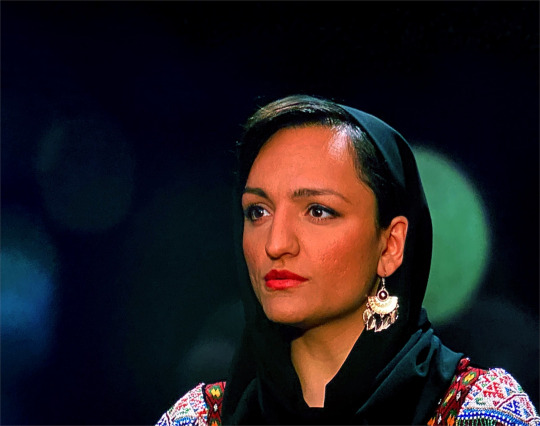
Zarifa Ghafari
You can read about life in Afghanistan before the 2021 Taliban takeover here and watch a documentary about life under the Taliban here.
4 notes
·
View notes